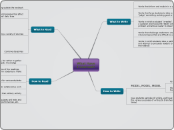What Have
I Learned?
What to Write
Works that allow students to express
and reflect upon their own life experiences
Works that inform and explain in a unique way
Works that force students to take a stance or
"judge" something as being good or bad
Works in which a student "wrestles" with
a question and hooks the reader with the
problem and allows reader to observe
Works that challenge students to analyze and
interpret topics that are difficult to understand
Works in which students take a particular position
and attempt to persuade readers to agree with
their stance
How to Write
MODEL, MODEL, MODEL
As a teacher, model the strategy
Show students mentor texts
from real-world situations
Give students samples of writing, and have them hunt for the various purposes of writing (6 branches of What to Write)
What to Read
Venturing outside the textbook
Using real world samples that affect
young students' daily lives
Using a variety of sources
Textbook
Magazines
Newspaper Articles
Websites
Combine disciplines
How to Read
Not to pass a test, but rather to gather
information and apply knowledge
Teacher selects some of the readings,
while also allowing for students to make
own choices
Differentiate texts for various students
Allow opportunities for collaborative work
Make reading a social activity rather than solitary activity
Assessment relies less on quizzes and tests and
more on complex projects/perfomances, etc.
